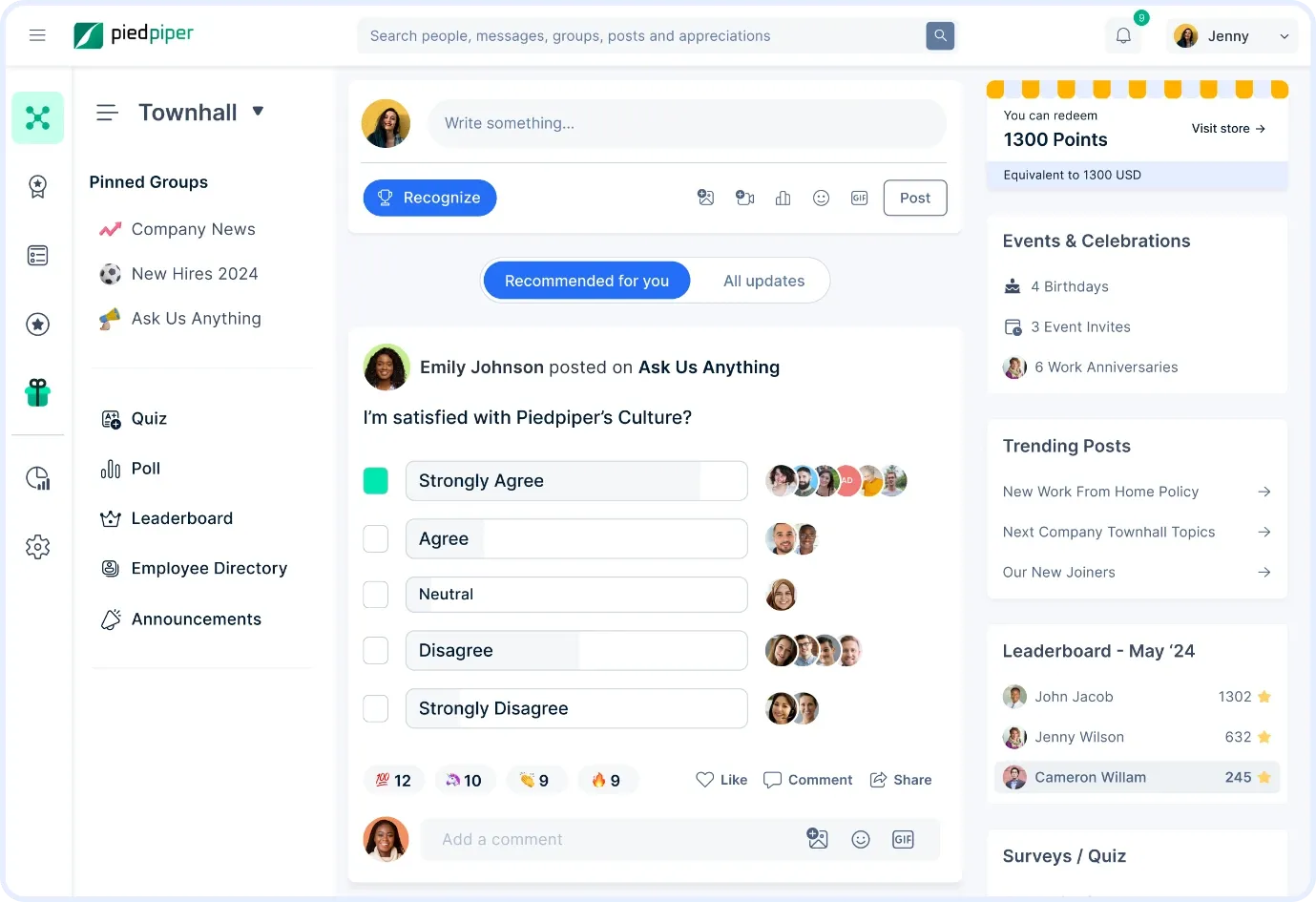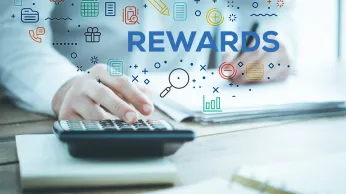10 Smart Time Management Hacks for Busy Professionals to Boost Productivity
Master your workday with these 10 expert-backed time management hacks. Learn how to stay productive, organized, and stress-free in a busy professional world.
In questa pagina
- What is time management and why is it crucial in today’s workplace?
- Why do professionals struggle with managing time?
- When should you start practicing better time management?
- 10 trucchi di gestione del tempo per migliorare la produttività dei dipendenti
- Who can benefit from these time management hacks?
- How Empuls helps improve time management at work
- Conclusione
Il tempo è una risorsa preziosa per tutti i professionisti che lavorano. Il desiderio di avere più delle solite 24 ore al giorno è un sentimento che molti possono condividere, ma il tempo rimane inafferrabile e scivola via inesorabilmente.
Modern-day professionals face significant time management challenges, especially with the rise of remote work. Surprisingly, research suggests that 82% of working professionals lack an effective time management system. This not only amplifies workplace stress but also spills over into their personal life, leaving individuals feeling overwhelmed.
The issue of time management is not solely an individual concern; it pervades workplaces everywhere. Studies reveal that the average corporate employee spends 51% of their workday on tasks with little to no value.
Employees may be wasting time gossiping with their co-workers or attending workplace celebrations in the physical workplace. On the other hand, in a remote setup, they may be wasting working hours unproductively scrolling on social media.
Given this reality, promoting modern time management practices is imperative in today's workplace. In this blog, we'll explore 10 essential time management hacks to rescue busy professionals and empower them to optimize their time for maximum productivity.
What is time management and why is it crucial in today’s workplace?
Time management is the art of planning, organizing, and executing tasks efficiently to make the most of the limited hours in a day. In today’s digital-first, hybrid work environment, professionals often find themselves struggling to stay focused and productive.
- AI-led nudges to promote healthy time usage
- Employee surveys to identify time-related stress triggers
- Recognition and rewards for efficient and impactful work
Why do professionals struggle with managing time?
Many professionals fall into time traps without realizing it:
- Lack of structure and pre-planning
- Distractions from notifications, meetings, or social media
- Inability to prioritize important tasks
- Perfectionism and procrastination
- Poor sleep or energy management
The modern workplace, whether physical or virtual, is full of interruptions. Recognizing these pitfalls is the first step to overcoming them.
When should you start practicing better time management?
Now. There’s no better time to improve time management than today.
Whether you're feeling overwhelmed, missing deadlines, or just want to improve your focus, starting applying the time management hacks immediately can bring tangible benefits like:
- Aumento della produttività
- Improved work-life balance
- Riduzione dello stress e del burnout
- Better decision-making and focus
Even small tweaks like tracking your day or creating a to-do list can yield major improvements in just a week.
10 trucchi di gestione del tempo per migliorare la produttività dei dipendenti
Ecco 10 trucchi di gestione del tempo per migliorare la produttività dei dipendenti:
1. Effettuare una verifica del tempo trascorso
Per ottimizzare il vostro tempo per ottenere una migliore produttività, dovete innanzitutto identificare come lo impiegate attualmente. A questo proposito può essere utile una verifica del tempo speso.
È necessario monitorare diligentemente il modo in cui si impiega il tempo durante una giornata lavorativa media. Una verifica del tempo impiegato può aiutarvi a determinare:
- Quali compiti potete svolgere in un giorno,
- Identificare le attività che forniscono i maggiori ritorni sugli sforzi compiuti e
- Individuate le attività o i momenti in cui potreste essere più produttivi.
Ecco alcuni passaggi che vi aiuteranno a condurre correttamente la verifica del tempo speso:
- Registrare tutte le attività svolte durante la giornata lavorativa e il tempo impiegato per ciascuna di esse.
- Tenete sotto controllo i vostri livelli di energia durante la giornata.
- Valutate la vostra energia, il vostro umore, la vostra motivazione e la vostra concentrazione ogni ora, su una scala da 1 a 10.
- Evitare, quando possibile, gli stimolanti esterni come la caffeina.
È necessario eseguire questo esercizio ogni giorno per una settimana.
Questo vi aiuterà a capire rapidamente quanto tempo viene speso in attività inutili. Avrete anche un'idea più precisa del tempo che impiegate per i diversi compiti e identificherete le vostre ore di massima produttività. Inoltre, allineando i compiti più impegnativi a queste ore principali, potrete massimizzare l'efficienza e rispettare le scadenze in modo efficace.
2. Creare un programma giornaliero in anticipo
Ammettiamolo. Siamo tutti colpevoli di aver perso tempo in cose che non aggiungono valore. Ma vi siete mai chiesti perché succede? Perché non avete un piano o un programma fisso.
Un programma giornaliero con un elenco organizzato di attività può risolvere questo problema. Programmare in anticipo può dare una direzione al modo di affrontare le cose e persino aiutare a bloccare il tempo. Vi sentirete meno ansiosi e avrete un quadro chiaro di ciò che vi aspetta.
Per creare un programma giornaliero:
- Dedicate 15-20 minuti prima di iniziare la giornata lavorativa per scrivere i vostri obiettivi quotidiani.
- Use the Pareto 80:20 principle to understand which activities to prioritize. As explained by Brian Tracy, the Pareto principle states that “20 percent of your activities will account for 80 percent of your results."
- Set deadlines for your goals while keeping Parkinson’s Law in mind. This rule states that "work expands to fill the time available for completion." This means that if you set a task deadline strictly rather than liberally, you can still complete it while saving time.
- Follow Eisenhower's Matrix model to boost productivity by categorizing tasks as urgent and important (do immediately), important but not urgent (schedule), urgent but not important (delegate), or neither (eliminate). This method enhances focus on key goals, improving time management and output.
3. Blocco temporale e raggruppamento di compiti simili
Il time-blocking è un potente strumento di produttività che prevede l'assegnazione di tempi specifici per i diversi compiti durante la giornata lavorativa. Questo metodo aiuta a ridurre le distrazioni e a mantenere la concentrazione sulle priorità principali.
Stabilire orari particolari per le attività favorisce una gestione efficace del tempo e garantisce che i compiti essenziali siano portati a termine in modo efficiente, evitando la sensazione di essere sopraffatti da richieste contrastanti.
Ecco una delle tecniche efficaci per il blocco del tempo:
- Pomodoro technique: A prominent time-blocking technique is the Pomodoro technique, developed in the 1980s. It advocates for concentrated work in 25-minute intervals followed by a 5-minute break. This cycle helps to reduce mental fatigue and maintain high motivation by balancing focused work with regular short breaks. After several Pomodoro cycles, a longer 15-minute break is recommended. You can easily access this pomodoro feature available in almost all time tracker apps.
In alternativa, si può anche optare per un time-boxing personalizzato per stabilire il proprio ritmo per le attività. Stimando il tempo che potrebbe richiedere ogni attività, si dedica ad essa una quantità specifica di tempo prima di passare alla priorità successiva, indipendentemente dal fatto che l'attività sia stata completata o meno. Questo approccio aiuta a rispettare i limiti di tempo autoimposti e a gestire in modo più realistico il carico di lavoro della giornata.
Il blocco dell'orario evita anche le distrazioni dovute a nuove attività che si presentano nel corso della giornata. Programmando orari specifici per attività di routine come archiviare, fare telefonate e rispondere alle e-mail, si può evitare la tentazione di controllare le notifiche in momenti non appropriati. Ciò è particolarmente utile nei periodi di lavoro intenso, in cui la concentrazione è fondamentale.
4. Automatizzare o delegare i compiti
Dando priorità a determinati compiti, sarà più facile capire se è possibile automatizzarli o delegarli. Questo può essere particolarmente utile se si lavora in una posizione dirigenziale.
Many managers unconsciously get into the habit of micro-managing in the workplace, and that is a waste of time for both parties. When you conduct a time audit and follow it up by creating an organized to-do list, you can identify such time-suckers and scale back on tasks that are not a priority for someone in your position.
You can automate non-priority tasks (using tools) or delegate them to another employee, team member, or even a virtual assistant! For example, sending sales emails that mostly read the same can be tedious and consume a lot of time for a sales manager. In such a scenario, they can either automate it using a CRM or email marketing automation software or delegate the task to a junior employee or a freelancer.
5. Identificare i fattori scatenanti della procrastinazione
About 20% of adults are chronic procrastinators, often due to a hyper-focus on perfectionism. Professionals often set high standards for themselves, ultimately leading to them not performing an activity altogether.
How to battle this? The first step is to begin the task without overthinking it too much and breaking the mental barrier to progress. You can use tools like a text to speech reader to process information more efficiently, aiding in task initiation and focus.
Oltre a questo, ci sono le distrazioni. Ecco alcune distrazioni comuni sul posto di lavoro e i modi migliori per attenuarle:
- Social media: Limit access using website blockers or designate specific break times for social media.
- Meetings: Have clear agendas, limit duration, or use brief stand-up meetings.
- Noisy environments: Use noise-canceling headphones, find quiet spaces, or work during less busy times.
- Constant notifications: Modify notification settings, turn off non-essential alerts, and schedule specific times to check messages.
Quando si limitano le distrazioni, è meglio iniziare a piccoli passi. Per un periodo di due settimane, individuate le due distrazioni che trovate più difficili da superare. Inoltre, una dieta sana, sonno sufficiente e idratazione sono fondamentali per mantenere la concentrazione, soprattutto quando si verifica il crollo pomeridiano.
6. Utilizzare la tecnologia per semplificare la giornata lavorativa
Technology is essential to time management because it offers tools and apps that increase productivity, automate repetitive tasks, and allocate time to real priorities.
Based on your needs, here’s a quick recommendation table:
Need | Recommended Tool/Method |
Task Management | Todoist, Asana |
Time Tracking | Time Doctor, RescueTime |
Focus & Deep Work | Forest, Pomodoro Technique |
Team Communication | Slack |
Mindfulness | Spazio di testa |
Automation | Zapier, Email Templates, CRMs |
7. Fare pause sufficienti per ricaricarsi
While taking a break may sound counterintuitive, studies show that the most productive workers focus on tasks for 52 minutes, followed by a 17-minute break. This quarter-hour window is often called productivity’s “golden hour.”
It lasts just long enough for your mind to switch off to feel rejuvenated, but not so long that you become distracted and lose track of what you are doing.
Frequent breaks improve memory, decision-making, mental health, and productivity, while skipping them can increase stress and hasten burnout. However, using these breaks for merely perusing social media or binge-watching OTT channels is not helpful.
During these windows, you should move your body—stand up from your chair, stretch, reach for a bottle of water, etc. You could also perform smaller jobs that take less than two minutes to complete during these intervals.
To ensure a good sleeping pattern, investing in a quality mattress can be beneficial. You should also:
- Stabilite un orario regolare per andare a letto e assicuratevi di dormire almeno 8 ore.
- Evitare l'uso di dispositivi intelligenti, poiché la luce blu dello schermo dello smartphone può interferire con il ciclo del sonno.
- Concedetevi frequenti ma brevi sonnellini di 15 minuti per ottenere un'immediata spinta alla produttività.
- Evitate la caffeina dopo le 17:00 e bevete invece una bevanda rilassante come la camomilla.
8. Evitare il multi-tasking per una maggiore concentrazione
Multi-tasking might sound like a great tactic for time management in theory, but realistically, it can be very counterproductive. This is because the human brain is not built to focus on multiple activities simultaneously.
Si può pensare che portare a termine una serie di compiti insieme faccia risparmiare tempo, ma il nostro cervello cambia contesto quando siamo multitasking. La giocoleria mentale comporta "costi di commutazione" che riducono il rendimento. Anche se il passaggio da un'attività all'altra può richiedere solo pochi secondi, se il multitasking è frequente, i costi si accumulano. Inoltre, si è più soggetti a rischi di errore e a una significativa riduzione della produttività a lungo termine.
9. Imparare a dire "no" quando le cose diventano opprimenti.
Nel mondo professionale di oggi è fondamentale riconoscere le nostre limitate energie quotidiane e l'importanza di dire no ai compiti non essenziali. Assumere un lavoro extra, soprattutto quando si devono affrontare scadenze ravvicinate, può ostacolare la capacità di portare a termine compiti importanti. Concentratevi sui vostri punti di forza e, se possibile, assegnate ad altri compiti che possano essere portati a termine in modo più rapido ed efficace.
Questo è un buon modo per praticare la mindfulness come strumento di gestione del tempo. È possibile utilizzare applicazioni di mindfulness come Headspace per diventare più consapevoli dei propri pensieri e delle proprie reazioni a determinati compiti e rimanere nel momento presente durante la giornata lavorativa. Tuttavia, la mindfulness come mentalità può essere difficile da coltivare per qualsiasi professionista.
Pertanto, prima di rifiutare un compito, considerate il suo impatto sul vostro tempo e sulla vostra energia, soppesate i pro e i contro e valutate la sua rilevanza per i vostri obiettivi quotidiani. Evitate di pensare troppo o di sentirvi in colpa per aver rifiutato compiti che non aggiungono valore alla vostra vita professionale.
10. Organizzare le cose (e mantenerle tali!)
Una gestione efficace del tempo passa soprattutto attraverso l'organizzazione. Una scrivania disordinata rende difficile trovare gli oggetti necessari, facendo perdere tempo e riducendo la concentrazione. L'organizzazione dello spazio di lavoro e dei processi aumenta la produttività, evitando scadenze non rispettate o compiti dimenticati.
L'aspetto positivo è che le capacità organizzative possono essere apprese facilmente. Ecco alcune nozioni di base:
- Maintain a decluttered desk: Visual clutter can often increase anxiety and stress, setting off a fight-or-flight reaction. Start by shredding or recycling any paper to help you make better decisions. Make room for necessities and place everyday equipment in convenient locations.
- Organize your calendar: You can differentiate and put life buckets on your calendar, like "personal," "professional," and "commitment." color code these to distinguish between categories or between urgent and non-urgent rapidly.
- coordinate shared files using Google Drive: Working in a company means that most files need to be accessed by more than one person. This is where using Google Drive may help. Name files appropriately and establish a structure that will make it simple and quick for you and your coworkers to find them.
- Have separate communication channels: Emails are great, but with evolving technology, you can now converse and update your team members using apps like Slack. Creating separate channels within your Slack workspace for different purposes and departments is advisable.
Who can benefit from these time management hacks?
These hacks are ideal for:
- Remote workers trying to balance home and work
- Managers seeking to delegate or lead efficiently
- Freelancers who juggle multiple projects
- Corporate employees overwhelmed with meetings and deadlines
- HR teams or team leads responsible for productivity training
Anyone feeling stuck in a time loop or looking to improve efficiency can benefit from these strategies.
- Intelligent insights into time usage and recognition gaps
- Automated reward cycles for efficiency achievements
- Slack/MS Teams integrations for in-flow productivity support
How Empuls helps improve time management at work

While individual hacks are essential, lasting impact comes when time management is embedded into the work culture. Empuls helps HR teams, managers, and employees practice effective time management by integrating technology, behavioral nudges, recognition, communication, and insights into the flow of work.
1. Reduce distractions with Empuls social intranet
Eliminate the need for scattered tools. Use Empuls’ social intranet to streamline company updates, townhalls, policy announcements, and employee conversations—all in one place.
Replace time-wasting chatter with focused, high-value discussions via community groups tailored to interests, projects, or departments.
2. Identify time sinks with AI-powered surveys & analytics
Use eNPS, pulse, and lifecycle surveys to discover how employees feel about their workloads, time pressures, or burnout risks.
Track changes and root causes over time with people analytics dashboards, then act on insights with data-backed action plans.
3. Reward productive habits with recognition & nudges
Empuls’ AI bot “Em” nudges employees to log their weekly accomplishments, making it easier for managers to give timely recognition and close visibility gaps.
Reinforce time-smart behaviors (e.g., consistent focus, meeting deadlines, delegating well) with core value badges, spot awards, or custom rewards.
4. Support energy management with perks & benefits
Reduce mental fatigue with perks like discounts on wellness, fitness memberships, and mental health apps.
Offer flexible fringe benefits (like remote work allowances or upskilling reimbursements) so employees can design workdays that optimize their productivity.
5. Automate low-value tasks to free up focus time
Automate greetings, milestones, service anniversaries, and celebration messages with Empuls’ award automation workflows—so managers don’t have to chase reminders.
Free HR teams from manual follow-ups by scheduling year-round reward cycles, notifications, and approval processes.
6. Promote mindfulness with recognition and community culture
Encourage reflection and focus with regular gratitude messages, Wishboards, and community recognition posts—creating a more mindful and appreciative digital workplace.
Conclusione
As the French philosopher Jean de La Bruyère once said, “Those who make the worst of their time most complain about its shortness.” Time is the most precious resource, and one can greatly enhance one's life by efficiently managing it with time management hacks.
I trucchi per la gestione del tempo discussi sopra si sono dimostrati utili per rompere vecchie abitudini inefficaci e svilupparne di nuove e produttive. Come qualsiasi altra abilità di vita, questi incredibili metodi possono essere padroneggiati solo con la perseveranza e la pratica.
Tuttavia, nessun suggerimento vi trasformerà magicamente in un esperto di gestione del tempo. Per vedere un vero cambiamento, dovete essere consapevoli che il tempo è una risorsa limitata. Abituatevi a documentare, organizzare e programmare le attività quotidiane in modo da sostenere i vostri obiettivi di gestione del tempo. Inoltre, monitorate regolarmente il tempo trascorso a svolgere le attività quotidiane per identificare eventuali interruzioni ricorrenti o cambiamenti di priorità.
Prioritize time today with time management hacks to become the most productive employee in your organization tomorrow! With deliberate planning, conscious usage, and the right digital support—like what Empuls provides—you can empower your people to own their time, reduce burnout, and drive business success.
Empuls doesn't just offer tools—it enables a cultural shift. One where:
- Employees feel recognized when they use time wisely.
- Managers coach based on insights, not assumptions.
- HR drives organization-wide productivity without burnout.
- Leaders see engagement, retention, and performance soar.
So, what are you waiting for again, schedule a call with our experts, now!













